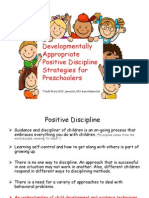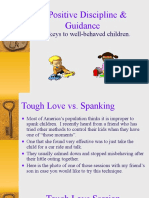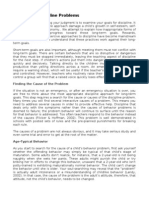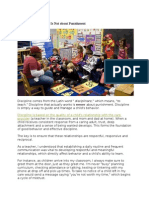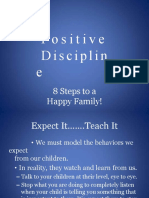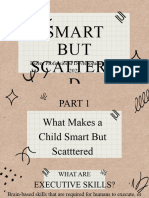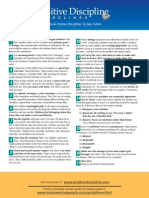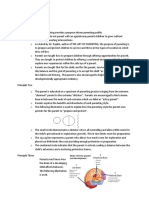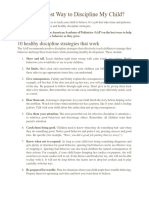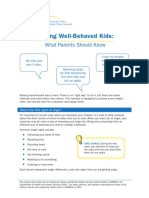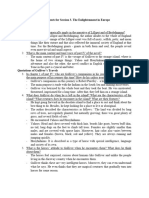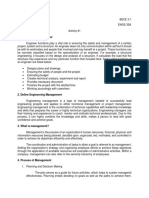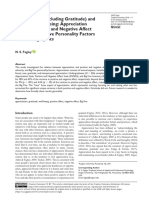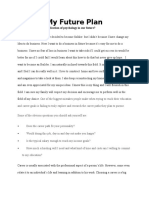Building Positive Discipline Strategies
What Is Positive Discipline?
Positive discipline focuses on teaching children appropriate behavior through guidance, understanding,
and mutual respect rather than punishment or rewards alone. This approach emphasizes building internal
motivation and self-regulation skills while maintaining warm, supportive relationships.
Core Principles
Connection Before Correction: Address the emotional needs underlying misbehavior before attempting
to correct it. Children need to feel understood and supported to learn effectively.
Focus on Solutions: Instead of dwelling on what went wrong, work together to find ways to handle
similar situations better in the future.
Teach Life Skills: View misbehavior as opportunities to teach important skills like problem-solving,
emotional regulation, and social cooperation.
Maintain Dignity: Discipline approaches should preserve both the child's and adult's sense of respect
and self-worth.
Setting Clear Expectations
Involve Children: Include kids in creating family rules and consequences. This builds ownership and
understanding of expectations.
Be Specific: Instead of saying "be good," specify desired behaviors: "Use walking feet inside the house."
Positive Framing: State what you want children TO do rather than focusing on what NOT to do. "Please
use your quiet voice" works better than "stop yelling."
Age-Appropriate Limits: Ensure expectations match developmental capabilities. Toddlers need simpler,
more concrete rules than school-age children.
Natural and Logical Consequences
Natural Consequences: Allow children to experience the natural results of their choices when safe. If
they refuse to wear a coat, they feel cold (unless weather is dangerous).
Logical Consequences: Implement consequences directly related to the misbehavior. If a child makes a
mess, they help clean it up.
�Timing Matters: Consequences should be immediate and brief. Long-term punishments often lose their
teaching value.
Learning Focus: Frame consequences as learning opportunities rather than punishment. "What can we
learn from this situation?"
Positive Reinforcement Techniques
Specific Praise: Acknowledge exact behaviors you want to see repeated. "Thank you for putting your
toys away without being reminded."
Effort Recognition: Praise the process and effort, not just outcomes. "I noticed how hard you worked on
that puzzle."
Non-Verbal Appreciation: Smiles, thumbs up, and high-fives can be powerful motivators for continued
positive behavior.
Intrinsic Motivation: Help children recognize how their positive choices make them feel proud and
accomplished.
Problem-Solving Approach
Cool-Down Time: When emotions are high, take a break before attempting to solve problems or discuss
behavior.
Listen First: Understand the child's perspective and feelings before offering solutions or explanations.
Brainstorm Together: Generate multiple solutions collaboratively. Children are more likely to follow
through on ideas they help create.
Try and Evaluate: Implement agreed-upon solutions and check back to see how they're working. Adjust
as needed.
Addressing Common Challenges
Defiance: Often signals a child's need for more autonomy or control. Offer appropriate choices and
involve them in decision-making.
Attention-Seeking: Provide regular positive attention when children are behaving appropriately,
reducing the need to seek attention through misbehavior.
Sibling Conflicts: Teach problem-solving skills and avoid taking sides. Focus on helping children work
together to find solutions.
�Power Struggles: Step back and avoid engaging in battles. Offer choices and redirect energy toward
cooperation.
Building Emotional Intelligence
Emotion Coaching: Help children identify and name their feelings. "You seem frustrated that your tower
fell down."
Coping Strategies: Teach specific techniques for managing difficult emotions, such as deep breathing or
taking space.
Empathy Development: Encourage children to consider others' perspectives and feelings in social
situations.
Self-Reflection: Ask questions that promote thinking about choices and their impact on others.
Consistency and Patience
Family Unity: Ensure all caregivers use similar approaches and language around discipline.
Long-Term Perspective: Building internal discipline takes time. Focus on progress rather than perfection.
Self-Care: Adults need support and breaks to maintain patient, positive approaches to discipline.
Modeling: Children learn more from what we do than what we say. Demonstrate the calm, respectful
behavior you want to see.




